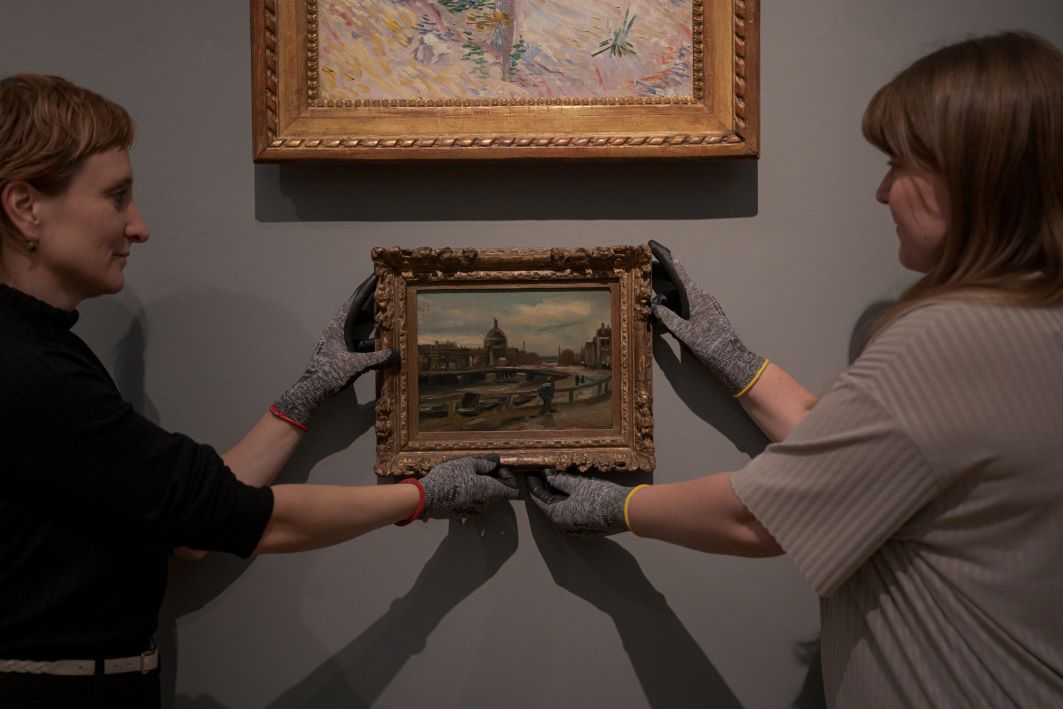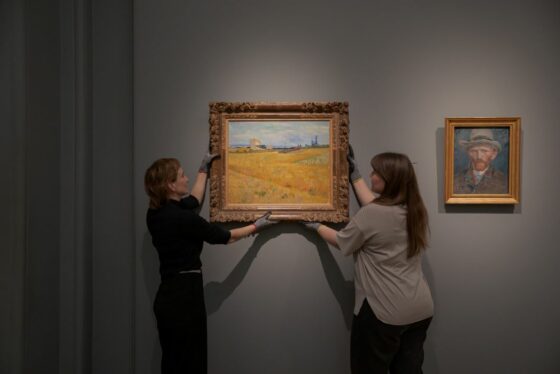The fingerprint and the mystery travels of a Van Gogh painting
Senay Boztas
A painting that Vincent van Gogh apparently carried with him on a visit to see the Dutch masters of painting at the Rijksmuseum – still wet in his bag, with a giant fingerprint on one corner – is hanging alongside them again.
The national museum in Amsterdam has a new, long-term loan of three Van Gogh paintings, including an early view of Amsterdam that experts believe he carried there in search of inspiration almost a century and a half ago.
According to Mayken Jonkman, curator of 19th century paintings, a large fingerprint discovered on the smallest and oldest loan, “View of Amsterdam from Central Station”, set them off on a search through history. Her theory is that Van Gogh took this painting with him when he visited the new Rijksmuseum in October 1885.
“Everything you see in his long-term development can be traced back to a visit in the October of 1885 to the Rijksmuseum,” said Jonkman at a private viewing on Monday. “The museum had just been open for a few months and Van Gogh, who was in Nuenen and had very little money, had saved up to go to Amsterdam.”
He travelled to Amsterdam on 6th and 7th October, according to his letters, taking a paint tin with him and creating several rough views of the Dutch capital.
“One of them is this one – painted on the second day, from the third class waiting room while waiting for his friend Anton Kerssemakers in an old train station at the level of the Westerdokstraat,” she said. “Then he probably took it – wet – to the museum and you could almost say it stood in the cloakroom while he went to look at Frans Hals and Rembrandt.”
Van Gogh wrote in his letters about his admiration of Hals and in particular of Rembrandt’s painting Isaac and Rebecca that day. Accounts from his friend Kerssemakers, coming across Van Gogh painting at the station, plus what appears to be a thumb print in the top, left-hand corner, suggest he took the work with him.
Not as crazy a theory as it sounds, said Jonkman: to facilitate the growing craze for impressionists painting in situ, artists’ bags were made with space for a wet board or canvas to be carried safely home.

Brighter palette
Van Gogh’s visit to see the great Dutch masters was a turning point in his movement away from dark, oppressive paintings of Dutch farm labourers to a brighter, colourful palette, Jonkman added. The two other paintings on loan, Riverbank with trees (1887) and Wheatfield (1888), were painted after he moved to France and show this bright colour scheme and his thick, impasto paint technique.
Conservator Sepha Wouda said that fingerprints were not unheard of on Van Gogh’s works but that this example was unusually large. “Oil paintings take a year to dry and you can see that it travelled while it was still wet,” she said. “You can also see the influence of the textile of a bag or case: it shows the signs of travel.”
The three works are on long-term loan from the P. en N. de Boer foundation in Amsterdam and will be hung for at least three years at the Rijksmuseum near Dutch artists who were influenced by Van Gogh.
Niels de Boer, board member and the great nephew of the founder, said Wheatfield is his favourite of the three paintings: “It cost 50,000 guilders when it was bought in 1940, the price of a building on the Herengracht.” Is it now worth a little more? “Certainly,” he said.
Thank you for donating to DutchNews.nl.
We could not provide the Dutch News service, and keep it free of charge, without the generous support of our readers. Your donations allow us to report on issues you tell us matter, and provide you with a summary of the most important Dutch news each day.
Make a donation